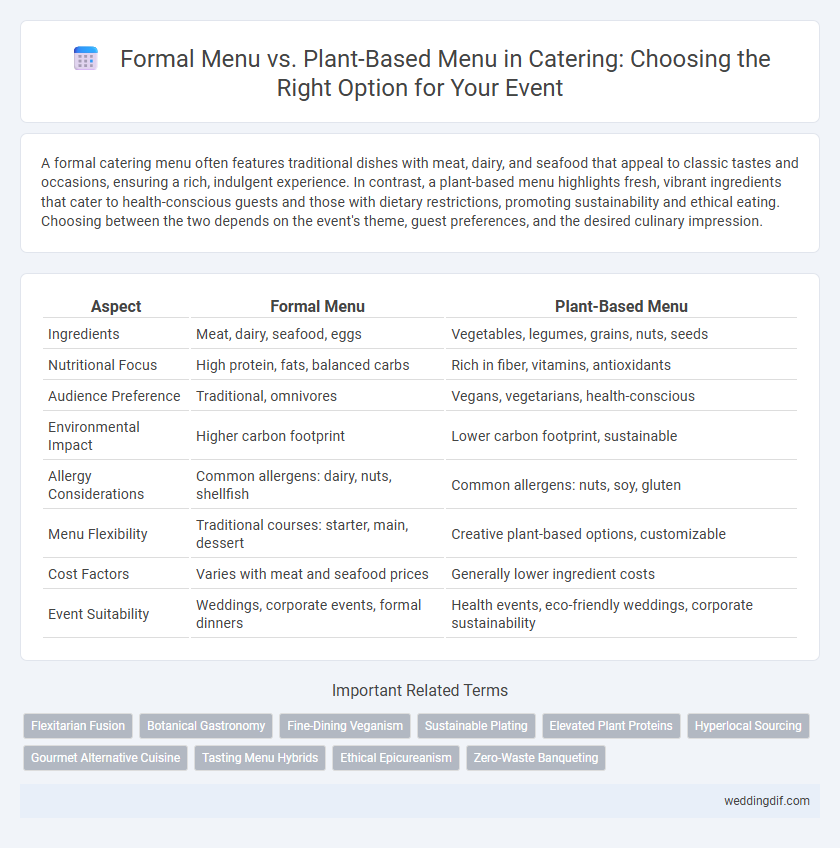A formal catering menu often features traditional dishes with meat, dairy, and seafood that appeal to classic tastes and occasions, ensuring a rich, indulgent experience. In contrast, a plant-based menu highlights fresh, vibrant ingredients that cater to health-conscious guests and those with dietary restrictions, promoting sustainability and ethical eating. Choosing between the two depends on the event's theme, guest preferences, and the desired culinary impression.
Table of Comparison
| Aspect | Formal Menu | Plant-Based Menu |
|---|---|---|
| Ingredients | Meat, dairy, seafood, eggs | Vegetables, legumes, grains, nuts, seeds |
| Nutritional Focus | High protein, fats, balanced carbs | Rich in fiber, vitamins, antioxidants |
| Audience Preference | Traditional, omnivores | Vegans, vegetarians, health-conscious |
| Environmental Impact | Higher carbon footprint | Lower carbon footprint, sustainable |
| Allergy Considerations | Common allergens: dairy, nuts, shellfish | Common allergens: nuts, soy, gluten |
| Menu Flexibility | Traditional courses: starter, main, dessert | Creative plant-based options, customizable |
| Cost Factors | Varies with meat and seafood prices | Generally lower ingredient costs |
| Event Suitability | Weddings, corporate events, formal dinners | Health events, eco-friendly weddings, corporate sustainability |
Comparing Formal and Plant-Based Catering Menus
Formal catering menus often emphasize classic dishes featuring animal proteins like beef, poultry, and seafood, designed to appeal to traditional tastes and suit upscale events. Plant-based catering menus prioritize fruits, vegetables, legumes, grains, and plant-derived proteins such as tofu or tempeh, catering to vegan, vegetarian, and environmentally conscious guests. Nutritional value, sustainability, and dietary restrictions play critical roles in determining menu selection, with plant-based options offering lower carbon footprints and reduced cholesterol levels compared to formal, meat-heavy menus.
Key Differences: Traditional Formal vs Plant-Based Wedding Catering
Traditional formal wedding catering typically features a curated selection of animal-based proteins such as beef, chicken, and seafood, paired with classic side dishes and rich sauces that emphasize indulgence and sophistication. In contrast, plant-based wedding catering prioritizes sustainable, cruelty-free ingredients like legumes, grains, vegetables, and plant-based proteins, focusing on health-conscious, environmentally friendly options that cater to vegan and vegetarian preferences. Key differences also include the flavor profiles, with formal menus leaning towards savory and rich tastes, while plant-based menus highlight fresh, vibrant, and nutrient-dense components to appeal to diverse dietary needs.
Pros and Cons of Formal Menus for Wedding Receptions
Formal menus for wedding receptions offer a curated dining experience with classic dishes that impress guests through sophistication and tradition. These menus can accommodate dietary restrictions but may limit creativity and exclude plant-based options, potentially reducing variety for vegan or vegetarian guests. The structured nature of formal menus ensures smooth service yet may increase costs and reduce flexibility in ingredient sourcing.
Benefits of Choosing a Plant-Based Wedding Menu
Choosing a plant-based wedding menu enhances sustainability by reducing carbon footprint and conserving water compared to traditional formal menus. Plant-based dishes offer diverse, nutrient-rich options that cater to various dietary restrictions and preferences, ensuring inclusivity for all guests. Emphasizing fresh, seasonal ingredients also elevates flavor profiles while promoting ethical and health-conscious dining experiences at catered events.
Guest Experience: Formal Menu vs Plant-Based Options
Formal menus typically offer a curated selection of classic dishes that emphasize luxury and presentation, enhancing guests' perception of elegance and tradition. Plant-based menus cater to dietary preferences and ethical considerations, increasing inclusivity and often providing vibrant, creative flavors that appeal to a diverse audience. Both approaches influence guest experience significantly, with formal menus elevating sophistication and plant-based options fostering health-conscious and environmentally aware enjoyment.
Presentation and Plating Styles: Formal vs Plant-Based Menus
Formal menus in catering emphasize intricate presentation with symmetrical plating, fine china, and classic garnishes that enhance visual appeal and elegance. Plant-based menus prioritize vibrant colors and diverse textures, often using natural edible flowers, microgreens, and rustic plating to highlight freshness and sustainability. The contrast in plating styles reflects the formality and thematic focus of each menu, influencing guest perception and dining experience.
Culinary Variety: Classic Dishes vs Plant-Based Creations
Formal catering menus traditionally feature classic dishes such as beef Wellington, lobster bisque, and creme brulee, offering rich flavors and elegant presentation that appeal to conventional palates. Plant-based menus emphasize creative culinary innovation, incorporating diverse ingredients like jackfruit, quinoa, and cashew-based cheeses to craft dishes that satisfy both flavor and nutrition. Catering services incorporating both options expand gastronomic variety, meeting the dietary preferences of diverse guests while maintaining high-quality dining experiences.
Dietary Restrictions and Inclusivity in Menu Planning
Formal catering menus often feature traditional dishes rich in dairy, gluten, and animal proteins, which can limit options for guests with dietary restrictions such as lactose intolerance, gluten sensitivity, or vegan preferences. Plant-based menus prioritize inclusivity by offering diverse ingredients free from common allergens and animal products, addressing dietary needs like veganism, vegetarianism, and food allergies more effectively. Incorporating plant-based options enhances menu flexibility and ensures a welcoming experience for all attendees, promoting health-conscious and ethical dining choices.
Cost Comparison: Formal Wedding Menu vs Plant-Based Menu
A formal wedding menu typically incurs higher costs due to the inclusion of premium ingredients like seafood, steak, and rich sauces, as well as the need for skilled culinary staff to execute complex preparation techniques. In contrast, a plant-based menu often results in cost savings through the use of seasonal vegetables, legumes, grains, and affordable plant-based proteins, reducing overall ingredient expenditure without compromising on taste or presentation. Catering services opting for plant-based menus may also benefit from lower environmental impact fees and increased appeal to health-conscious guests, influencing budget allocation positively.
Sustainability Impact: Traditional vs Plant-Based Catering Choices
Traditional formal catering menus often rely heavily on animal-based products, contributing significantly to greenhouse gas emissions, water usage, and land degradation. Plant-based menus, by contrast, drastically reduce environmental footprints through lower resource consumption and enhanced biodiversity preservation. Choosing plant-based catering options supports sustainability goals by minimizing carbon emissions and promoting eco-friendly food systems.
Formal menu vs plant-based menu for catering. Infographic

 weddingdif.com
weddingdif.com